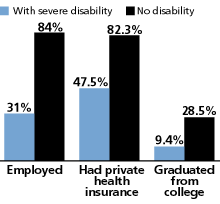
Boomers' Retirement Wave Likely to Begin in Just 6 Years
(April 2002) In the United States, efforts to stop terrorism and restore economic growth have superseded the Social Security issue for the past several months. But the clock keeps ticking, and baby boomers are nearing retirement. The public and Congress need to decide how to restructure Social Security to enhance its long-term solvency. Structural changes, even if enacted this year, probably would not take effect before many boomers start collecting retirement benefits, and further delay will only make changes more difficult.
The first of the boomers will be 65 in 2011, often cited as the year when the age wave will arrive. Yet for over a decade, more than half of the new recipients of Social Security benefits have opted to collect them at age 62, and close to 70 percent have done so before age 65. Consequently, it is more realistic to anticipate the leading edge of the boomer wave hitting in 2008 — only six years from now.
A recent Census Bureau projection of people ages 60 to 64 indicates the numerical impact of the arrival of the boomers (see table below). From the low levels of the economically depressed 1930s, the number of births rose in the early 1940s despite World War II, and then accelerated in the late 1940s with the end of the war. Further increases occurred in the family-oriented 1950s, with the baby boom peaking in the late 1950s and early 1960s. These trends mean that the number of people 60 to 64 years old is projected to rise 19 percent between 2000 and 2005, and 51 percent by 2010. By 2020, the number of adults ages 60 to 64 is expected to be nearly twice the number in 2000. Thus, the numerical impact of the boomers will be both substantial and long-lasting.
Table 1
Number of People Ages 60 to 64
| Year | Number (in millions) | % Change Since 2000 | 5-Year Birth Intervals | |
|---|---|---|---|---|
| 2000 | 10.8 | N/A | 1936-1940 | |
| 2005 | 12.8 | 19 | 1941-1945 | |
| 2010 | 16.3 | 51 | 1946-1950 | baby boom |
| 2015 | 18.5 | 71 | 1951-1955 | |
| 2020 | 20.7 | 92 | 1956-1960 | |
| 2025 | 20.8 | 93 | 1961-1965* | |
*The baby boom lasted from 1946 to 1964.
Sources: U.S. Census Bureau, 2000 data (www.census.gov/Press-Release/www/2001/ tables/dp_us_2000.PDF, accessed Feb. 22, 2002); 2005-2025 data (www.census.gov/ population/www/projections/natsum-T3.html, accessed Feb. 22, 2002).
Furthermore, the number of years during which the swelling number of retirees will be able to collect their benefits may continue to grow beyond the current averages of 18 years for men and 22 years for women. The duration of retirement has grown because of increased longevity and a lower average age at retirement. From the early 1950s to the late 1990s, the median age at which workers 50 years of age or older exited the labor force fell about five years for men and six years for women (see table below). The average age at initial award of Social Security benefits followed a very similar trajectory.
Table 2
Estimated Average Age at Retirement of Men and Women
| Labor Force Data1 | Social Security Data2 | |||
|---|---|---|---|---|
| Interval | Men | Women | Men | Women |
| 1950-1955 | 66.9 | 67.6 | 68.53 | 67.93 |
| 1960-1965 | 65.1 | 64.6 | 65.0 | 65.0 |
| 1970-1975 | 63.4 | 62.9 | 62.9 | 62.9 |
| 1980-1985 | 62.8 | 62.7 | 62.9 | 62.8 |
| 1990-1995 | 62.44 | 62.34 | 62.7 | 62.6 |
| 1995-2000 | 62.04 | 61.44 | 62.6 | 62.55 |
Notes: 1: Labor force data indicate median age at exit from the labor force for reasons other than death of five-year cohorts ages 50 and older. 2: Social Security data indicate mean age at initial award of benefit for retirement or disability, the latter limited to those ages 50 and over. The disability data have been included to provide better comparability with the labor force data. 3: In Social Security data for 1950-1955, age data for disability awards are not available. If they were, the means would be lower. 4: Average ages in the labor force series for 1990-2000 were calculated from data adjusted to levels prior to the 1994 revision of the CPS. Unadjusted medians are: men 1990-1995, 62.1; men 1995-2000, 62.0; women 1990-1995, 62.6; women 1995-2000, 61.8. 5: In the Social Security series, the mean retirement age for 1997 was 65.4, much higher than the means since the 1960s or in 1998 or 1999. It was, therefore, regarded as an anomaly and disregarded. The data for both women and men are limited to 1995-1999.
Sources: Social Security Bulletin, Annual Statistical Supplement, 1999 (Social Security Administration, 1999); and Bureau of Labor Statistics. For more information about the labor force data, see Murray Gendell and Jacob S. Siegel, “Trends in Retirement Age by Sex, 1950-2005,” Monthly Labor Review, July 1992, pp. 22-29.
Since longevity is expected to continue to increase — with the only questions now being how fast and by how much — whether retirement will continue to lengthen will depend on the future course of the median age at exit from the labor force. Economist Joseph F. Quinn has contended that recent changes in public policy and in the private sector have begun to reverse the trend to early retirement. But another economist, Dora L. Costa, doubts that these changes are strong enough to counter the influence of the long-term increase in the income of workers, which she regards as the main reason for the decline in retirement age and for the great increase in attractive and affordable leisure activities available to the elderly. Given this uncertainty about whether or when retirement age will reverse its downward course, and about the pace and extent of the rise in longevity, it would be unwise to expect any shortening of retirement. It would, rather, be prudent to expect some further expansion, albeit a modest one.
Some policy changes are now taking effect. Between 2000 and 2005, the normal retirement age of 65 is being raised two months per year. When it reaches 66, as it will in 2008, it will not rise again (to 67) until 2017. Also changing is the percentage by which Social Security benefits are reduced for people who choose early retirement. When the full retirement age was 65, taking the benefit at 62 meant receiving only 80 percent of the benefit available at 65; when retirement age reaches 66, the comparable figure will be 75 percent. It is doubtful that this change will reduce the percentage of workers taking the benefit at 62 because the trade-off between getting the reduced benefit for years and getting the full benefit at the normal retirement age will be no less favorable than before. In both cases, the worker who does not collect before the normal retirement age will have received less money for the first 12 years.
The retirement of the first of the baby boomers is imminent. Their sheer numbers will swell the size of the retired population for two decades, and they will be collecting Social Security benefits for a long time. We cannot afford to keep putting off coping with this issue.
Murray Gendell is senior research associate at Georgetown University’s Center for Population Research.
For More Information
See Murray Gendell, “Retirement Age Declines Again in 1990s,” Monthly Labor Review, October 2001, for an account of the disagreement between Professors Quinn and Costa on the relative strength of the factors likely to determine the future course of retirement age, and for a fuller description of both the decline in the average age at retirement and the increase in its duration. Articles in the Monthly Labor Review, published by the Bureau of Labor Statistics, may be accessed from www.bls.gov. In the “Publications and Research Papers” section, click on “Monthly Labor Review Online,” “Archives,” and “October 2001, Vol. 124, No. 10.”

Emerging Trends in Disability
(September 2001) Disability is an ambiguous demographic, but one that is unambiguously increasing. Socioeconomic trends such as aging and other factors have contributed to the growth of the population categorized as disabled, making disability an important issue for policymakers, even though its definition is often a point of contention.
Many sources of U.S. disability data are collected in conjunction with federal beneficiary programs such as Social Security or with state-administered programs in education, vocational rehabilitation, and health care.
The major sources of population data are the National Health Interview Survey (NHIS, conducted by the National Center for Health Statistics) and three data programs of the U.S. Census Bureau: the decennial census, the Current Population Survey (CPS), and the Survey of Income and Program Participation (SIPP). Because the NHIS and SIPP cover a wider range of topics than the decennial census and the CPS, they serve as the primary sources for population research in disability.
The SIPP gathers information on specific functional losses or limitations — for example, inability to lift or difficulty walking — as well as on selected impairments. Disability identification in the NHIS emphasizes limitation in the performance of a major social role, such as working, self-care, or attending school. Key to comparing data from the two surveys is understanding that only a fraction of people reporting functional limits have difficulty fulfilling socially defined roles and that not everybody with an activity limitation has a functional limitation that can be captured in a survey.
Ambiguity in definition notwithstanding, a significant number of Americans live with a disability. In 1997, the prevalence of disability as measured by the NHIS was 13 percent of the noninstitutionalized U.S. population, or 35 million people. Under the broader, functional limits conception of the SIPP, the 1997 rate was close to 20 percent, or approximately 53 million people.
Factors Associated With Increased Disability
Several demographic, socioeconomic, and medical trends, and one major piece of legislation, have direct ties to rising rates of disability:
- Aging. The impact of an aging population on disability prevalence is straightforward. (See the February/March 2001 issue of Population Today.) Nearly three out of four Americans over the age of 80 had a disability in the form of a limitation on a basic functional activity in 1997.
- Poverty. Estimates derived from NHIS data for 1983 to 1996 indicate a significant increase in the rate of childhood disability, from 5.8 percent to 6.8 percent of the noninstitutionalized population under age 21, with virtually all of the increased prevalence attributable to children living in poverty. As both a consequence and cause, poverty has long been linked to disability. In the 1997 SIPP, 28 percent of adults ages 25 to 64 with a severe disability lived in poverty, compared with 8.3 percent for the general population; poverty rates under the NHIS were 27 percent with an additional 19 percent of disabled Americans considered “near poor” (with incomes up to twice the official poverty cutoff). Americans with a disability are at a substantial disadvantage in employment, access to private health insurance, and levels of educational achievement (see figure below).
- Medical Advances. Survival across a wide spectrum of diseases and traumas has improved due to medical advances. For example, survival rates for spinal cord and severe brain injury have dramatically increased in recent decades due to better trauma care. These two forms of injuries account for an estimated 80,000 new people with a disability each year, according to the National Institutes of Health. Similarly, survival rates for low birth-weight infants have increased 70-fold over the past 25 years, directly affecting the prevalence of developmental conditions and learning impairments.
- Emerging Conditions. “Emerging” conditions are syndromes around which there is recent recognition or consensus, such as multiple chemical sensitivity and chronic fatigue syndrome (CFS), or established conditions such as asthma, autism, mental illness, and learning disorders that appear to be growing in prevalence. A common point of dispute is whether reported increases represent growth in actual incidence, greater awareness, and better surveillance, or simply the reduction of stigma in reporting.
Among the recently recognized conditions, prevalence estimates tend to be relatively small and vary widely due to the absence of universal case definitions. For example, physician-based estimates for CFS ranged from 3.8 to 9.6 cases per 100,000 people in an analysis of urban areas done by the Centers for Disease Control and Prevention.
Among the established conditions with recent dramatic changes in prevalence, attention deficit hyperactivity disorder (ADHD) is perhaps prototypical. The number of children identified with the disorder has exploded over the past decade and is now estimated to represent 3 percent to 5 percent of all school age children. It is widely suspected, however, that much of the growth is due to increased awareness and access to improved treatment options. - The Americans With Disabilities Act (ADA). The ADA defines disability as a physical or mental impairment that substantially limits one or more major life activities or as being regarded as having such an impairment. This latter definition takes into account discriminatory decisions based on stereotypes rather than on actual limitations — for example, the presence of facial disfigurement or impairment that does not directly affect performance. In 2000, the U.S. Supreme Court significantly narrowed the interpretation of the definition, ruling that people do not have a disability if impairments can be corrected or do not substantially limit activities.
Disability Status and Economic Disadvantage

Source: Jack McNeil, “Americans With Disabilities: 1997,” Current Population Reports P70-73, February 2001; accessed online at www.census.gov/prod/2001pubs/p70-73.pdf on July 16, 2001.
In 1993, sociologist Irving Zola described the futility of pinpointing the exact size of the population with disability, noting that disability represents “a set of characteristics everyone shares to varying degrees.” There is dynamism in disability status both because of the transitory character of health and because the connection between a person’s impairment and subsequent loss of function is often determined by barriers in his or her physical environment. The legal skirmishes over the definition of disability under the ADA underscore this dynamism, making disability less a concern of medicine and more the province of broadly based civil rights protections.
Glenn T. Fujiura is associate professor and director of graduate studies in the Department of Disability and Human Development at the University of Illinois at Chicago.
References
Vidya Bhushan, Nigel Paneth, and John L. Kiely, “Impact of Improved Survival of Very Low Birth Weight Infants on Recent Secular Trends in the Prevalence of Cerebral Palsy,” Pediatrics 91, no. 6 (1993): 1094-1100.
Centers for Disease Control and Prevention (CDC), “Arthritis Prevalence and Activity Limitations — United States, 1990,” Morbidity and Mortality Weekly Report 43, no. 24 (1994): 433-438.
CDC, “Trends in the Prevalence and Incidence of Self-Reported Diabetes Mellitus — United States, 1980-1994,” Morbidity and Mortality Weekly Report 46, no. 43 (1997): 1014-1018.
Glenn T. Fujiura and Kiyoshi Yamaki, “Trends in Demography of Childhood Poverty and Disability,” Exceptional Children 66 no. 2 (2000): 187-199.
Institute of Medicine, Disability in America: Toward a National Agenda for Prevention, eds. Andrew M. Pope and Alvin R. Tarlov (Washington, DC: National Academy Press, 1991).
H. Stephen Kaye et al., “Trends in Disability Rates in the United States, 1970-1994,” Disability Statistics Abstracts 17 (Washington, DC: U.S. Department of Education, National Institute on Disability and Rehabilitation Research, 1996).
Mitchell P. LaPlante and Dawn Carlson, “Disability in the United States: Prevalence and Causes, 1992,” Disability Statistics Reports 7 (Washington, DC: U.S. Department of Education, National Institute on Disability and Rehabilitation Research, 1996).
Jack McNeil, “Americans With Disabilities: 1997,” Current Population Reports (March 2001): 70-73.
National Center for Health Statistics, Health, United States, 2000 (Hyattsville, MD: Centers for Disease Control and Prevention, 2000).
National Eye Institute, Vision Research — A National Plan: 1999-2003: A Report of the National Eye Advisory Council (Bethesda, Md.: National Institutes of Health, 1998).
National Institutes of Health, “Diagnosis and Treatment of Attention Deficit Hyperactivity Disorder,” NIH Consensus Statement 16, no. 2 (Nov. 16-18, 1998).
National Institutes of Health, “Rehabilitation of Persons With Traumatic Brain Injury,” NIH Consensus Statement 16, no. 1 (Oct. 26-28, 1998).
P.W. Reis, “Prevalence and Characteristics of Persons With Hearing Trouble: United States, 1990-91,” Vital and Health Statistics Series 10 (data from the National Health Interview Survey), no. 188 (1994).
David B. Reuben, Kathleen K. Walsh, and Gail A. Greendale, “Hearing Loss in Community-Dwelling Older Persons: National Prevalence Data and Identification Using Simple Questions,” Journal of the American Geriatrics Society 46, no. 8 (1998): 1008-1011.
Michele Reyes et al., “Surveillance for Chronic Fatigue Syndrome — Four U.S. Cities, September 1989 Through August 1993,” Morbidity and Mortality Weekly Report 46, no. SS-2 (1997): 1-13.
Irving K. Zola, “Disability Statistics, What We Count and What It Tells Us: A Personal and Political Analysis,” Journal of Disability Policy Studies 4, no. 2 (1993): 9-39.






